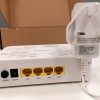NO! Your Broadband Almost Certainly Won’t “grind to a halt” Today

Over the past few days’, we’ve seen a succession of scaremongering newspaper articles, which appear to warn UK consumers that their wireless routers or broadband may “grind to a halt” during this week’s heatwave. The articles appear to have been triggered by some advice that Virgin Media issued, but the reality is that this week’s weather won’t cause any major broadband issues.
Some of the articles that we’re talking about can be found here, here and here. Most of the headlines give the impression that a mass broadband outage may be in the offing, which is despite the fact that this is all based off some simple common-sense advice that Virgin Media issued, where they advised customers to keep their routers (Hubs) “out of bright sunlight” due to the risk that they may “slow down … or even grind to a halt altogether“.
First things first, this week’s “heatwave” is pretty tame and expected to peak into the high 20s in some areas. On the one hand, that’s fairly warm for this time of year and part of the world. But on the other hand, it’s not a patch on the 40c+ heatwave that much of the country experienced in 2022 (much more of a concern) and is below the more typical and often location specific summer peaks of c.35-38c. Small and often very isolated outages are still possible in warm weather, but for the vast majority of people there’s really no need to worry, and we have not seen a noticeable spike in complaints.
Advertisement
All electronic devices generally do emit some heat, even if you can’t always feel it, and the least efficient ones tend to produce more than most. Most router manufactures are aware of this and design their hardware to operate at temperatures of up to around 40c (varying a bit between manufacturers).
Sadly, an overheating broadband ISP router is something that can happen, although even many of the devices with a stated tolerance of up to 40c may actually continue to function for a handful of degrees past that point. But experiences do vary, and we should point out that your mobile phones, laptops, game consoles, tablets and other electronics may also run into their own issues.
However, a router that overheats, or which nears the point of overheating, will often do one of several things. The most likely outcome is that the device’s processor (CPU / APU) will throttle back and performance will be degraded, which could affect response times on the device’s User Interface (UI) and might also impact your LAN and WiFi speeds or connection stability. But this will also lower the heat output and protect the device.
Sometimes routers, just like other electronics, will get so hot that they restart themselves. But in most cases, this is only temporary, and the device will quickly return to normal, causing a short connection drop. Only very rarely does this result in complete hardware failure and, as we say, a 20-28c style heatwave is generally well within the tolerance of most such networking kit.
Advertisement
Suffice to say, nobody should worry, and the vast majority of people are already sensible enough NOT to stick such kit in direct sunlight or place it on top of an existing heat source (it doesn’t take a heatwave to break a router if you do this). Otherwise, we’ll repeat the same tips we’ve given in the past.
ISPreview’s Top Tips for Keeping Broadband Routers Cool
1. Never place it in direct sunlight, obviously.
2. Never allow your pet to use the router as its own personal sleeping mat. Yes, it might seem cute, but the slim risk of this causing an electrical fault, fire or overheating is something best avoided. Just remember, cats can be jerks, so they won’t obey your orders and even placing said device within a ring of defensive orange peel may not be enough to stop their unwanted advances toward your personal centre of internet excellence.
3. Place the router on a hard and flat surface (ideally something cool), which should allow the air to move freely around it (especially below the device). Wall mounting the device can also help (vertically), provided the wall itself isn’t transmitting a lot of heat (e.g. south facing walls with no cavity insultation will get warmer). In other words, never put your router on a surface that doesn’t allow heat to escape.
4. Some older / cheaper routers and chipsets are more susceptible to heat problems, especially if they’ve had a lot of usage, and at the extreme you might need to consider buying a newer device. Mind you, having an ultra powerful device can sometimes be similarly problematic. Granted, this is a pretty rubbish “tip“, so let’s move on.
5. Consider buying a cheap laptop size cooling mat / pad for the router. Kit like this can be had for around £15-£30 (examples) and often includes a small internal USB fan, which is handy because some routers include low-power USB ports that can be used to run the fan(s). Alternatively, any old cheap fan pointed at the router will do, but this probably isn’t really necessary for this week’s heatwave.
6. If the heat is truly horrific in your home (i.e. 40c+), then it may be wise to switch the router off when not in use. In fact, get out of the house yourself and find shade. But don’t restart it too often if you’re on an older DSL (ADSL, FTTC etc.) based connection, as they don’t respond well to being repeatedly switched on and off during the day (can result in a loss of speed). But in our experience, there’s usually not much harm in turning it off once in the day for a period, although this really is a last resort.
7. Disable non-critical router services when not needed. The less the router has to do, the less heat it will produce and the faster it can operate. Some routers allow you to disable specific services (e.g. wifi, connection logs etc.) and, during hot weather, this can help to keep the device running smoothly. On the other hand, it’s probably best not to fiddle with these things unless you know what you’re doing.
8. Situate the router in the coolest room possible, which is often the lowest point in your home with the thickest walls. Unfortunately this might constrain the performance of your wireless network, thus there’s a careful balancing act to consider.
9. Buy Air Conditioning for your home, provided you can afford the energy bills or have a solar/battery system to off-set the usage.
Hopefully it goes without saying that pouring ice or ice water over your router, or even putting it in the fridge, are both things that should be avoided.
Mark is a professional technology writer, IT consultant and computer engineer from Dorset (England), he also founded ISPreview in 1999 and enjoys analysing the latest telecoms and broadband developments. Find me on X (Twitter), Mastodon, Facebook, BlueSky, Threads.net and Linkedin.
« Primary UK Mobile Operators Beat Virtual MVNOs for Broadband Speed























































We’ve seen an increase in line faults on copper services with the heat. The various Amazon Prime matches have been causing more issues – various wholesale networks showing peak time congestion during the matches, and other ISPs running out of peering/transit capacity during the matches
Well yes? the copper will move with the heat/cooling cycle. Its one of the benefits of moving away from copper – to remove these failures.
Backhaul capacity at wholesale has nothing to do with the temperature. Just people being too tight to actually have capacity now people are trying to actually use it.
LOL Seriously. Sounds like Virgin Media are trying to attempt behaviourally modifying customers to stop there network from getting overwhelmed.
Amazon do a USB powered fan that cools pretty well. It is not that expensive. I made my own and they are capable of cooling my pfsense firewall by easily 15 centigrade and ONT by 10 centigrade.
I use two tiny fans facing down on my pfSense NUC, powered by a USB slot on the NUC itself, their default speed is too high, so have a power attenuator to slow them down, works very well, its inaudible, unless I get real close and I am focused on listening to it.
It is primarily to cool the NVME and RAM, but the CPU benefits as well, similar to you roughly 15C.
Goes to show far too many people blindly believe whatever they see online without questioning what they’re reading.
If they actually put their brain in gear, they’d realise a few summers ago it was far, far hotter and there was no broadband meltdown then!
Ironically my provider has suffered a major outage since around 9:30 this morning and it is STILL on going, my provider uses Gigaclear’s network unfortunately. So I have had no internet beyond my phone all day…
Jinxed: I had just read to the end of the comments earlier this morning when pop! My EE broadband connection was dropped, and the router struggled to reconnect.